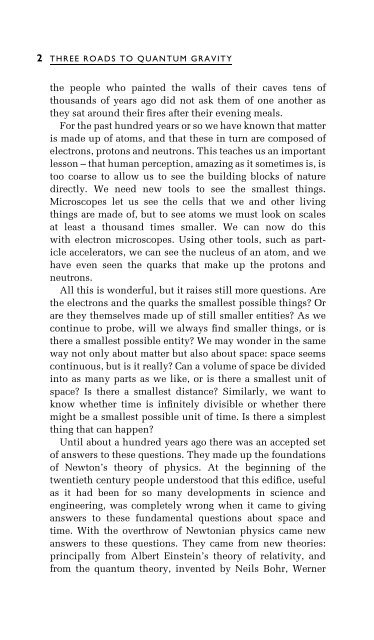Three Roads To Quantum Gravity
Three Roads To Quantum Gravity
Three Roads To Quantum Gravity
You also want an ePaper? Increase the reach of your titles
YUMPU automatically turns print PDFs into web optimized ePapers that Google loves.
2 THREE ROADS TO QUANTUM GRAVITY<br />
the people who painted the walls of their caves tens of<br />
thousands of years ago did not ask them of one another as<br />
they sat around their ®res after their evening meals.<br />
For the past hundred years or so we have known that matter<br />
is made up of atoms, and that these in turn are composed of<br />
electrons, protons and neutrons. This teaches us an important<br />
lesson ± that human perception, amazing as it sometimes is, is<br />
too coarse to allow us to see the building blocks of nature<br />
directly. We need new tools to see the smallest things.<br />
Microscopes let us see the cells that we and other living<br />
things are made of, but to see atoms we must look on scales<br />
at least a thousand times smaller. We can now do this<br />
with electron microscopes. Using other tools, such as particle<br />
accelerators, we can see the nucleus of an atom, and we<br />
have even seen the quarks that make up the protons and<br />
neutrons.<br />
All this is wonderful, but it raises still more questions. Are<br />
the electrons and the quarks the smallest possible things? Or<br />
are they themselves made up of still smaller entities? As we<br />
continue to probe, will we always ®nd smaller things, or is<br />
there a smallest possible entity? We may wonder in the same<br />
way not only about matter but also about space: space seems<br />
continuous, but is it really? Can a volume of space be divided<br />
into as many parts as we like, or is there a smallest unit of<br />
space? Is there a smallest distance? Similarly, we want to<br />
know whether time is in®nitely divisible or whether there<br />
might be a smallest possible unit of time. Is there a simplest<br />
thing that can happen?<br />
Until about a hundred years ago there was an accepted set<br />
of answers to these questions. They made up the foundations<br />
of Newton's theory of physics. At the beginning of the<br />
twentieth century people understood that this edi®ce, useful<br />
as it had been for so many developments in science and<br />
engineering, was completely wrong when it came to giving<br />
answers to these fundamental questions about space and<br />
time. With the overthrow of Newtonian physics came new<br />
answers to these questions. They came from new theories:<br />
principally from Albert Einstein's theory of relativity, and<br />
from the quantum theory, invented by Neils Bohr, Werner



![arXiv:1001.0993v1 [hep-ph] 6 Jan 2010](https://img.yumpu.com/51282177/1/190x245/arxiv10010993v1-hep-ph-6-jan-2010.jpg?quality=85)


![arXiv:1008.3907v2 [astro-ph.CO] 1 Nov 2011](https://img.yumpu.com/48909562/1/190x245/arxiv10083907v2-astro-phco-1-nov-2011.jpg?quality=85)








![arXiv:1002.4928v1 [gr-qc] 26 Feb 2010](https://img.yumpu.com/41209516/1/190x245/arxiv10024928v1-gr-qc-26-feb-2010.jpg?quality=85)
![arXiv:1206.2653v1 [astro-ph.CO] 12 Jun 2012](https://img.yumpu.com/39510078/1/190x245/arxiv12062653v1-astro-phco-12-jun-2012.jpg?quality=85)
